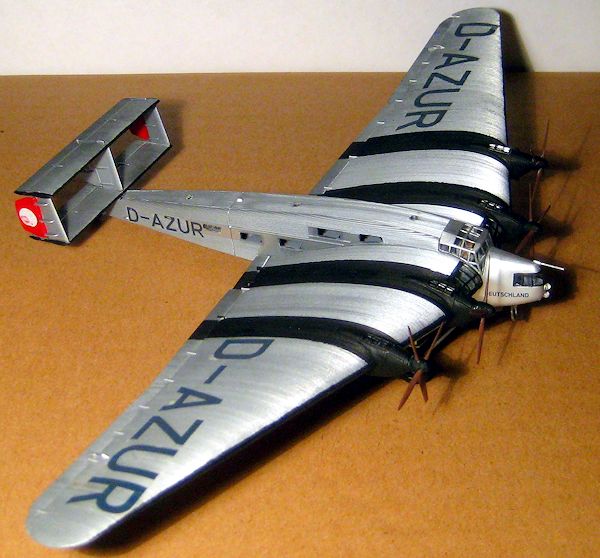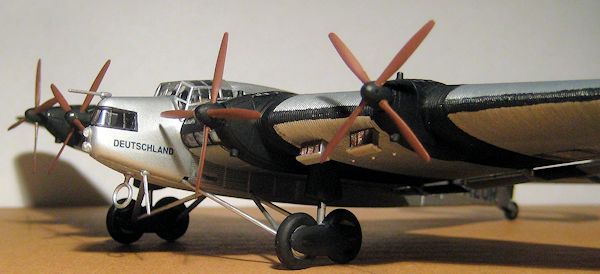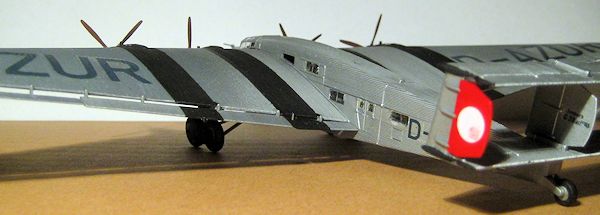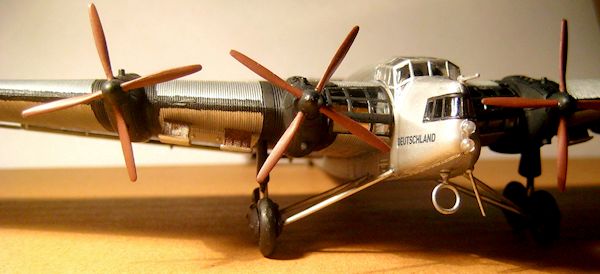
| HISTORY |
Junkers started out as a boiler maker - who knew?
The company is more famous today for its aeroplanes. One, the notorious Stuka divebomber, left its awful, ugly mark across Poland and the small countries of northwest Europe, as well as other fields of battle during world war two. An unpleasant legacy, really, for an innovative company. Its founder, Hugo Junkers, died in 1935 and seems to have been hounded out of his own company by disgruntled shareholders in 1931, only to have the Nazis force him to hand over his privately-owned patents a few years before he d
 ied. One can
only imagine that Hugo, reportedly a pacifist, must have
turned in his grave more than once as the Blitzkrieg rained
down in 1939 and 1940 from planes carrying his name.
ied. One can
only imagine that Hugo, reportedly a pacifist, must have
turned in his grave more than once as the Blitzkrieg rained
down in 1939 and 1940 from planes carrying his name.
A lot of modelers like the Ju-88, and some the Ju-87, but
for me, it's Junkers' earlier corrugated skin planes that
are most memorable, and most interesting.
The most famous of course is the tri-motor "Tante Ju" (Aunt
Ju), the Ju-52 transport that also served the Nazi war
machine wherever its infamy left its stain.
But this monster, the G.38, was pre-Nazi, and the fruit of
Hugo's design expertise and innovation. At the time (very
early 30s) it was the largest land plane in the world.
What's really cool about the G.38 is the passenger
accommodation. Apart from the great seats in the nose, there
were also seats inside the huge wing, with big front windows
giving what must have been an incredible view. In the
fuselage, there were smaller cabins a bit like a first class
railway coach. There was even a smoking room.
Lufthansa had two of these in service - D-AZUR and D-APIS.
If you see pictures of D-2000 or D-2500, these are the same
two planes, just earlier in their lives. Lufthansa had
scheduled service between Berlin, Hanover, Amsterdam and
London. D-AZUR was written off in a crash in 1936, and
D-APIS continued with Lufthansa until the war, when it was
taken over by the Luftwaffe as a transport plane. It was
destroyed by the RAF in Athens, 17 May 1941.
Japan had six of these, licence built as the Ki-20. None
survive.
I can imagine this plane starring in
the next installment of Indiana Jones - assuming poor old
Harrison Ford is finally pensioned off and they go to the
back story, maybe a prequel to the first film. The young
Indy would have some witty banter with a mysterious,
beautiful woman, like Cary Grant in "North by Northwest",
and then he'd fight off some dastardly Nazis. "Nazis! I hate
these guys", he'd say as they boarded the plane, and we'd
all cheer as he beat them, one by one, and got the girl.
| THE KIT |
Our editor reviewed this kit a while back right here on MM:
I picked mine up on a trip through
Hong Kong about two years ago, and found it to be very nice,
just as described in the preview.
| CONSTRUCTION |
This thing has a pretty decent interior, with floors and seats for the various different passenger cabins, and seats and sticks for the pilots. You need to put most of the windows in before sealing the fuselage. The main cockpit and the forward-facing windows can wait until later if you want. I painted the inside but once it's sealed up you don't see a lot in the fuselage area. Th
 e wing cabins and cockpit are a
different story, so I put in a little more effort here.
e wing cabins and cockpit are a
different story, so I put in a little more effort here.
I found the fit to be very good, although not perfect.
Because of the fine corrugations, you don't want to be doing
too much putty and sanding. So although there were a few
imperfect joins, I left them as they were. Generally, the
worst join is under the fuselage, at the nose. The top panel
fits well (note that the fuselage is put together with sides
top and bottom, not the typical left and right half of most
kits).
Once the fuselage is together, the wings go on easily and
fit well because the wing roots are installed deep inside
the fuselage - that is, there isn't really a join you have
to worry about.
I left the trailing edge flaps off
until the very end (and managed to get super glue everywhere
including all over my hands, which briefly had a flap stuck
to them. Glad I got that off before the glue dried. It could
be quite socially awkward having a 1/144 Junkers flap
permanently attached to one finger...).
| COLORS & MARKINGS |
I used a spray can - Tamiya AS-14 - to do this one. A few blasts and it was done. The plastic is practically the same colour so I needed to be careful that I had actually sprayed the whole thing. When that was dry, I hand painted the red tails, and I masked off and brush painted the black stripes (top and bottom). There was a little bit of leaching under the tape, because the corrugations
 make it hard to get a
really strong tape-down (yeah I know that's not a word).
make it hard to get a
really strong tape-down (yeah I know that's not a word).
Other smaller parts were hand painted. I freelanced the
canopy lines after adding the transparencies once the whole
thing was painted. I started this kit in one country and finished it in
another, and along the way, some of the side windows were
lost. They will probably turn up one day.
I had a lot of trouble with the decals. I don't want to be
the proverbial poor workman who blames his tools, but I
can't help thinking these were not the best decals in the
first place. They seemed a bit thick, took a while to come
off, and then didn't seem to be very clingy. Obviously, with
this corrugated surface, they had very little to cling too.
I tried my best with various techniques, mostly
 involving
copious amounts of Mr Mark Softer. In some areas, it looks
great, while in others, usually on the same decal, you can
clearly see the mess.
involving
copious amounts of Mr Mark Softer. In some areas, it looks
great, while in others, usually on the same decal, you can
clearly see the mess.
 involving
copious amounts of Mr Mark Softer. In some areas, it looks
great, while in others, usually on the same decal, you can
clearly see the mess.
involving
copious amounts of Mr Mark Softer. In some areas, it looks
great, while in others, usually on the same decal, you can
clearly see the mess.
From a bit of a distance though it still looks pretty good,
so I pressed on (having come that far) and finished her up.
"No swastikas in mi casa", so I left it with white circles
(which Mr Mark Softer turned into white circles with a red
smudge).
I must get around to touching those up
with white paint.
| CONCLUSIONS |
A fantastic looking plane - weird, interesting, and not very common. An easy to construct kit, of good quality. A simple paint scheme. All thoroughly commendable. The decals - well, I guess it was mostly me, but I do wonder just a little bit if mine were a bit old, or "stale", if you can describe decals in that way. Still, I enjoyed this one and I like having it on my shelf of 1/144 airliners. And I learned something I didn't know about Hugo Junkers.
| REFERENCES |
